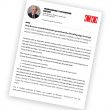Modern contact centers are built for so much more than most organizations ever tap into. Despite enterprises investing heavily in powerful CX platforms, underused contact center features are everywhere and they’re costing companies real ROI. From agent efficiency to customer satisfaction, these overlooked features can deliver powerful outcomes – if you know how to use them and they’re integrated properly.
After three decades in the industry, one truth remains clear: the tools aren’t the problem – platform underutilization is.
Here are five underused contact center features that, when fully activated, become strategic game-changers.
1. Speech and Text Analytics: One of The Most Underused Contact Center Feature
This is arguably one of the most underused contact center features in the industry today. Organizations capture thousands of customer conversations across voice, chat, and digital—but only a small percentage is reviewed manually.
Modern platforms now come with built-in speech and text analytics, allowing contact centers to automatically analyze 100% of their interactions and improve their customer experience. That means you can uncover real-time insights on customer sentiment, agent performance, trending issues, and more—without listening to a single call or reading a single transcript.
Most organizations use this powerful feature in a limited way—just for compliance monitoring (e.g., verifying required disclosures) or quality assurance (scoring a small sample of calls). That leaves a huge amount of untapped potential on the table.
When used strategically, speech and text analytics becomes a CX intelligence engine. It helps you:
- Detect root causes of dissatisfaction, churn, or escalations
- Identify process and product issues early
- Capture the behaviors of top-performing agents—not just low performers
- Share customer insights across Sales, Product, and Marketing
The technology is already there. The opportunity lies in moving beyond checkbox compliance—and turning every customer interaction into a driver of business growth and customer experience improvements.

2. AI-Powered Agent Assist: Your Real-Time Support Co-Pilot
Even with modern platforms, too many agents still scramble through disconnected knowledge bases, outdated FAQs, or wait on supervisors for help. This slows down resolution times and frustrates customers.
That’s where AI-powered agent assist comes in—providing real-time guidance, knowledge surfacing, and recommended actions during live interactions.
So why is this among the most underused contact center features?
- Many teams underestimate the impact on speed and service quality
- Knowledge bases are often outdated or fragmented
- Some fear the complexity of integration or change management
But when AI in contact centers is implemented right, agent assist delivers:
- Shorter average handle times
- Better onboarding and faster time-to-productivity for new agents
- More consistent, high-quality service across the board
This isn’t just a tool—it’s a performance booster. And for contact centers under pressure to do more with less, it’s a missed opportunity if left on the shelf.
3. Omnichannel Routing with Context: The Most Misunderstood Contact Center Feature
It’s common to see companies offering multiple channels—voice, chat, email, social—but few actually deliver a true omnichannel experience. That’s because customers are constantly being forced to repeat themselves when they switch channels, and agents lack full visibility into previous interactions.
Omnichannel routing is the solution—and yet it remains one of the most underused contact center features. When done right, it ensures that customer history, preferences, and intent follow them from one touchpoint to the next.
Why this is often missed:
- Legacy platforms are patched together, creating “Frankenstack” systems
- Routing rules are often built in silos by channel, not around journeys
- Integration complexity deters investment
Done right, omnichannel routing:
- Reduces customer frustration and repeated effort
- Improves agent efficiency by providing full context
- Boosts satisfaction scores and resolution rates across all channels
This feature is about mindset as much as technology: designing journeys around the customer, not your org chart.
4. Workforce Engagement Management (WEM): More Than Scheduling
Ask most operations leaders what Workforce Engagement Management (WEM) tools are for, and you’ll hear “scheduling” or “adherence tracking.” But today’s WEM capabilities go well beyond logistics—they’re central to culture, coaching, and retention.
Despite that, WEM remains one of the most underused contact center features—often because teams stop at the basics.
Here’s what modern WEM can deliver:
- Gamification to motivate behaviors that drive KPIs
- Targeted coaching based on performance insights
- Real-time recognition to reinforce and reward top talent
- Burnout detection and wellbeing monitoring for better retention
The contact center workforce is your frontline brand. When you treat WEM as a culture-building tool—not just a scheduler—you unlock higher engagement, lower attrition, and better customer experiences as a result.

5. Proactive Outbound Engagement: A Legacy Feature Reinvented for Modern CX
Outbound communication used to be synonymous with robocalls and reminder dialers. But today, it’s one of the most underused contact center features in the modern CX arsenal—and one of the most versatile.
Modern platforms enable proactive, intelligent outreach across SMS, voice, email, and mobile apps. Yet many organizations still silo outbound or avoid it altogether, assuming it’s outdated or intrusive.
When done right, proactive outbound engagement:
- Reduces inbound volume through reminders and updates
- Deflects calls by addressing common questions before they happen
- Enhances loyalty by creating timely, relevant customer touchpoints
Examples include:
- Text alerts with links to reschedule or confirm
- Push notifications on app orders or service updates
- CRM-driven outreach for renewals or proactive support
If your outbound tools are still just dialing numbers, you’re missing the real CX potential they were built for.
Final Takeaway: Don’t Let These Contact Center Features Collect Dust
The truth is that most companies with contact centers have already purchased the technology they need. What’s missing is activation—a strategy to put underused features to work where they can make the biggest impact.
To recap, ask yourself:
- Are we using analytics to inform strategy, or just checking QA boxes?
- Is agent assist part of every customer interaction—or sitting idle?
- Are our routing strategies customer-centric or channel-specific?
- Does WEM improve culture—or just monitor compliance?
- Is our outbound communication reactive—or proactively creating value?
These underused contact center features aren’t optional extras. They’re proven drivers of efficiency, satisfaction, and competitive advantage.
You’ve already invested in the tools. Now it’s time to learn how to use them. Contact us to start getting more from your contact center platform.








